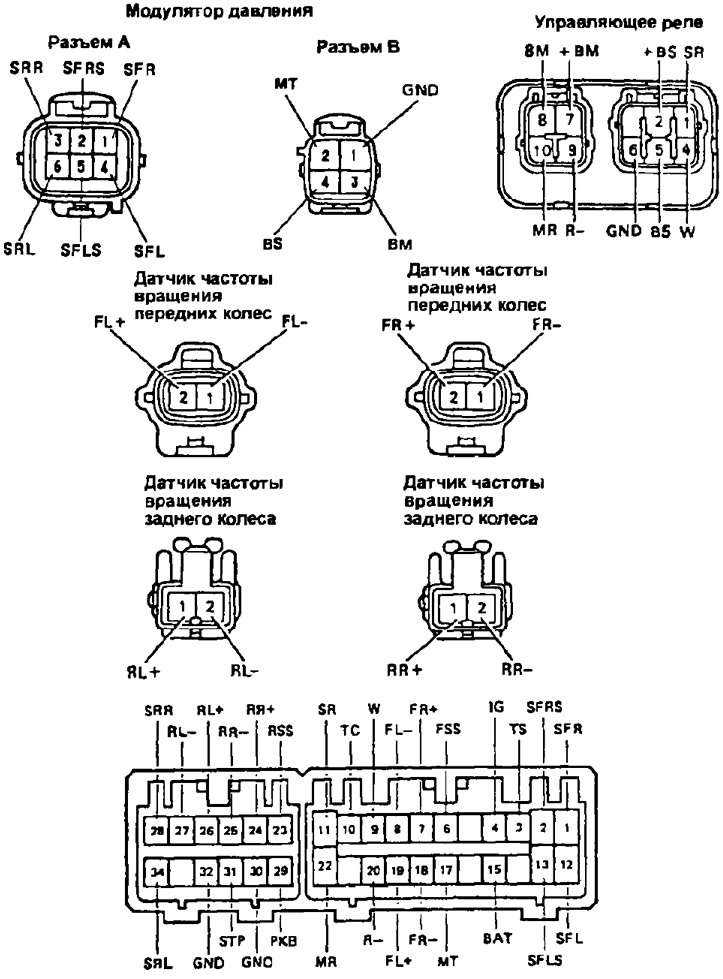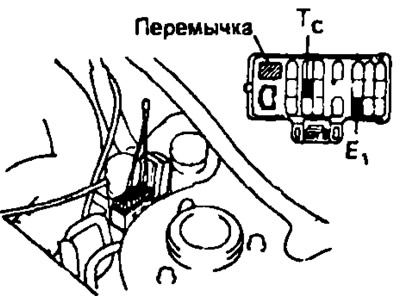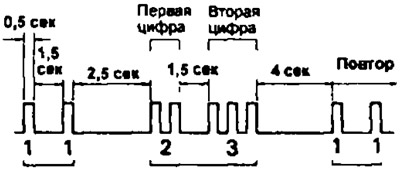
1. Check that the battery voltage is about 12V.
2. Checking the ABS indicator.
- A) Turn on the ignition.
- b) Check that the ABS indicator lights up for 3 seconds.
- V) If the indicator does not illuminate, check, repair or replace (if necessary) fuse, indicator lamp and wiring harness.
3. Reading the fault code.
- A) Turn on the ignition.
- b) Short the leads "Ts" And "E1" diagnostic socket.
 |  |
- V) Remove the service jumper from the terminals "WA" And "WB" diagnostic connector in the engine compartment.
- G) In the event of a malfunction, after 4 seconds the indicator will start flashing. Count the number of flashes.
Note:
- The fault code consists of two digits, the first digit is determined by the initial series of flashes, then, after a pause of 1.5 seconds, a second series of flashes follows, which corresponds to the second digit of the code.
- If there are two or more fault codes, the smallest code will be displayed first, and then the remaining codes in ascending order. There will be a 2.5 second pause between codes.

- d) If there is no fault, the indicator will flash at 0.5 second intervals.

- e) After troubleshooting, erase the codes stored in the electronic control unit.
Note: If you disconnect the battery, all fault codes stored in the electronic control unit will be erased.
- and) Disconnect Leads "Ts" And "E1" diagnostic socket.
- h) Install a jumper on the pins "WA" And "WB".
- And) Turn the ignition on and check that the ABS indicator goes off after igniting for three seconds.
Resetting DTCs
- A) Tighten the parking brake lever.
- b) Turn on the ignition.
- V) Short the leads "Ts" And "E1" diagnostic socket.
Note: This operation must be carried out with the vehicle stationary.
- G) Press the brake pedal 8 or more times within 3 seconds to reset the fault codes stored in the ABS control unit.
- d) Check that the indicator flashes correspond to the no fault code (interval 0.5 seconds).
- e) Disconnect Leads "Ts" And "E1" diagnostic connector
- and) Check that the indicator is off.
Troubleshooting
1. If the ABS indicator lights up constantly after the ignition is turned on and when driving.
- A) Remove the service jumper from the diagnostic connector and short the leads "Ts" And "E1" Check for fault codes (ignition on)
- b) Check the correct connection of the connector to the ABS control unit and the presence of all pins in the connector
- V) With the ignition on, check for a voltage of 10-16 V between the terminal "IG" control unit connector and "earth" If there is no voltage, then the power circuit is faulty.
- G) With the ignition off, disconnect the control unit connector and the diagnostic connector. Turn on the ignition. If the indicator remains on, then there is a short circuit in the wiring between the terminal "W" ABS control unit and terminals "W" control relay. If the indicator goes out, then the control unit is faulty.
2. The ABS indicator does not light up for 3 seconds after the ignition is turned on.
- A) With the ignition off, remove the jumper and ground the terminal "W" on the socket. Turn on the ignition. If the indicator does not light up, then the lamp is faulty or there is an open circuit between the indicator and the output "W" control relay.
- b) With the ignition off, disconnect the connectors from the control unit and control relay and ground the output "W" or the connector of the control unit from the side of the wires. Turn on the ignition. If the indicator does not light up, then there is an open circuit between the indicator and the terminals "W" control unit
- V) With the ignition off, disconnect the control relay connectors and check for continuity between the terminals "W" And "BS" from the side of the modulator. Reverse the polarity of the connection and check again. If the conductivity is one-sided, then the control unit is faulty. If the conductivity is not one-sided, then there is a short circuit in the diode inside the control relay.
Note: If a diode is short-circuited, the output "IG is inoperable. When checking the output, connect the control unit connector and disconnect the diagnostic connector and the pressure modulator connector. Then turn on the ignition. If the indicator does not light up, then the output on the control unit is faulty.
3. If the ABS indicator lights up and goes out, then check for a short circuit between the terminals "Ts" And "E1" diagnostic socket.
4. If the car pulls to the side when braking, it means that the brakes are not effective enough, ABS is activated during normal braking, ABS is activated before stopping during normal braking; strong pulsation of the brake pedal during ABS operation:
- A) Remove the jumper and short the leads "Ts" And "E1" diagnostic socket.
- b) With the ignition on, check for any trouble codes.
- V) Check that the speed sensors are installed correctly and that the tightening torques of the set bolts are within acceptable limits.
- G) Check the diagnostic system of speed sensors and deceleration sensor. If the signal level is abnormal, check the speed sensors and replace if necessary.
- d) Check the diagnostic system of speed sensors and deceleration sensor. If the signal change is normal, then check the sensor rotors and replace if necessary.
- e) Disconnect the connector from the ABS control unit and check the continuity between the terminals of the speed sensors on the wire side. Speed sensor wiring is faulty if abnormal changes in conductivity occur when twisting or bending is attempted.
- and) Check for foreign material or swarf at the end of the sensor.
- h) Check the functioning of the deceleration sensor through the diagnostic system. If the sensor is not working properly, then either the sensor is defective or not installed correctly.
- And) Check the function of the pressure modulator. If the modulator is working properly, then replace the control unit.
5. If rubber slipping sound is heard during ABS operation (ABS doesn't work well enough).
- A) Remove the jumper and short the leads "Ts" And "E1" diagnostic socket.
- b) With the ignition on, check for any trouble codes.
- V) Check the voltage between the output "STP" control unit and "earth" with the brake pedal depressed. If the voltage does not match the battery voltage, then there is an open circuit between the brake light switch and / or an open wiring
- G) Check pressure modulator.

Diagnostics of speed sensors
Attention: when diagnosing the speed sensors, the brake system works as usual (ABS not working).
1. Check that the battery voltage is about 12V.
2. Check the ABS indicator.
- A) Turn on the ignition.
- b) Check that the ABS indicator lights up for 3 seconds. If the indicator does not illuminate, check and replace or repair the fuse, lamp, or wiring as needed.
- V) Check that the ABS indicator goes out.
- G) Switch off the ignition.
3. Perform the following sequence of operations.
- A) Short the leads "Ts" And "E1" diagnostic connector in the engine compartment.
- b) Apply the parking brake lever and start the engine.
- V) Make sure the indicator flashes at a rate of 4 times per second.

4. Check while driving.
- A) Release the parking brake lever.
- b) Accelerate the vehicle to a speed of more than 80 km/h for a few seconds.
5. Reading trouble codes.
- A) Stop the car. The indicator will flash.
- b) Short the leads "Ts" And "E1" diagnostic socket.
- V) Determine the number of flashes of the ABS indicator.
Note:
- During normal operation, the indicator blinks at a frequency of 2 times per second.
- If there are two or more faults, the fault with the lowest code will be displayed first.
6. Replace or repair faulty system components.
Note: When repairing or replacing ABS parts, turn off the ignition.
7. Disconnect Leads "Ts", "Ts" And "E1" diagnostic socket.

Fault codes 72 and 76

